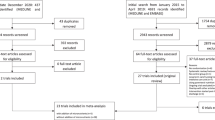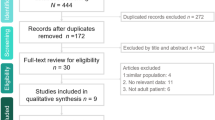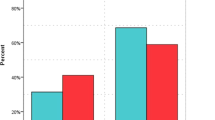Abstract
Background:
In vitamin A-deficient populations, children hospitalized with infections and/or malnutrition are at particular risk of developing severe vitamin A (VA) deficiency. High-dose VA supplements are recommended as part of the treatment but results on its effect on recovery from morbidity and on prevention from nosocomial morbidity are conflicting.
Objective:
We aimed to assess the effect of a single high dose and daily low dose of VA on hospitalized malnourished children's morbidity.
Design:
We carried out a double-blind, randomized trial in 604 and 610 Senegalese hospitalized children. The first mentioned batch received a high-dose VA supplement (200 000 IU) on admission, the second a daily low-dose VA supplement (5000 IU per day) during hospitalization. Children were followed up until discharged. Data on all-cause morbidity were collected daily.
Results:
Survival analysis showed that the incidence of respiratory disease was significantly lower in the low-dose group than in the high-dose group, hazard ratios (HR): 0.26, 95% CI: 0.07–0.92. The duration of respiratory infection was also significantly lower in the low-dose group than in the high-dose group (HR of cure: 1.41, 95% CI: 1.05–1.89). Duration and incidence of diarrhoea were not significantly different between treatment groups. In children with oedema on admission, mortality was significantly lower in the low-dose group (Adjusted odds ratio: 0.21; 95% CI: 0.05–0.99).
Conclusions:
Daily low dose of VA compared with single high dose significantly reduced duration and incidence of respiratory infection but not of diarrhoea in hospitalized children.
This is a preview of subscription content, access via your institution
Access options
Subscribe to this journal
Receive 12 print issues and online access
$259.00 per year
only $21.58 per issue
Buy this article
- Purchase on Springer Link
- Instant access to full article PDF
Prices may be subject to local taxes which are calculated during checkout
Similar content being viewed by others
References
Barclay AJG, Foster A, Sommer A (1987). Vitamin A supplements and mortality related to measles: a randomised clinical trial. BMJ 294, 294–296.
Beau J-P, Garenne M, Diop B, Briend A, Diop Mar I (1987). Diarrhoea and nutritional status as risk factors of child mortality in a Dakar hospital (Senegal). J Trop Pediatr 33, 4–9.
Bresee J, Fischer M, Dowell S, Johnston BD, Biggs VM, Levine RS et al. (1996). Vitamin A therapy for children with respiratory syncytial virus infection: a multicenter trial in the United States. Pediatr Infect Dis J 15, 777–782.
Coutsoudis A, Broughton M, Coovadia HM (1991). Vitamin A supplementation reduces measles morbidity in young African children: a randomized, placebo-controlled, double-blind trial. Am J Clin Nutr 54, 890–895.
Dewan V, Patwari AK, Jain M, Dewan N (1995). A randomised controlled trial of vitamin A supplementation in acute diarrhea. Indian Pediatr 32, 21–25.
Dibley MJ, Goldsby JB, Staehling NW, Trowbridge FL (1987). Development of normalized curves for the international growth reference: historical and technical considerations. Am J Clin Nutr 46, 736–748.
Donnen Ph, Dramaix M, Brasseur D, Bitwe R, Vertongen F, Hennart Ph (1998). Randomized placebo-controlled clinical trial of the effect of a single high dose or daily low doses of vitamin A supplementation on morbidity of hospitalized malnourished children. Am J Clin Nutr 68, 1254–1260.
Ellison JB (1932). Intensive vitamin A therapy in measles. BMJ 2, 708–711.
Faruque ASG, Mahalanabis D, Haque SS, Fuchs GJ, Habte D (1999). Double-blind, randomised, controlled trial of zinc or vitamin A supplementation in young children with acute diarrhoea. Acta Paediatr 88, 154–160.
Fawzi WW, Mbise RL, Fataki MR, Herrera MG, Kawau F, Hertzmark E et al. (1998). Vitamin A supplementation and severity of pneumonia in children admitted to the hospital in Dar es Salaam, Tanzania. Am J Clin Nutr 68, 187–192.
Fawzi WW, Mbise R, Spiegelman D, Fataki M, Hertzmark E, Ndossi G (2000). Vitamin A supplements and diarrheal and respiratory tract infections among children in Dar es Salaam, Tanzania. J Pediatr 137, 660–667.
Friedman A, Meidovsky A, Leitner G, Sklan D (1991). Decreased resistance and immune response to Escherichia coli infection in chicks with low or high intakes of vitamin A. J Nutr 121, 395–400.
Henning B, Stewart K, Zaman K, Alam AN, Brown KH, Black RE (1992). Lack of therapeutic efficacy of vitamin A for non-cholera, watery diarrhea in Bangladeshi children. Eur J Clin Nutr 46, 437–443.
Hossain S, Biswas R, Kabir I, Sarker S, Dibley M, Fuchs G et al. (1998). Single dose vitamin A treatment in acute shigellosis in Bangladeshi children: randomised double-blind controlled trial. BMJ 316, 422–426.
Hussey GD, Klein M (1990). A randomized, controlled trial of vitamin A in children with severe measles. N Engl J Med 323, 160–164.
Ingenbleek Y, Van Den Schrieck HG, De Nayer P, De Visscher M (1975). The role of retinol-binding-protein in protein-calorie malnutrition. Metabolism 24, 633–641.
Julien MR, Gomes A, Varandas L, Rodrigues P, Malveiro F, Aguiar P et al. (1999). A randomised, double-blind, placebo-controlled clinical trial of vitamin A in Mozambican children hospitalised with non-measles acute lower respiratory tract infections. Trop Med Int Health 4, 794–800.
Kjolhede CL, Chew FJ, Gadomski AM, Marroquin DP (1995). Clinical trial of vitamin A as adjuvant treatment for lower respiratory tract infections. J Pediatr 126, 807–812.
Mahalabanis D, Lahiri M, Paul D, Gupta S, Gupta A, Wahed MA et al. (2004). Randomized, double-blind, placebo-controlled clinical trial of the efficacy of treatment with zinc or vitamin A in infants and young children with acute lower respiratory infection. Am J Clin Nutr 79, 430–436.
McNally L, Tomkins A (2001). A review of the evidence for the benefits and safety of adding vitamin A to the treatment of six common health problems in children. Bull WHO 22, 295–310.
Nacul LC, Kirkwood BR, Arthur P, Morris SS, Magalhaes M, Fink MCDS (1997). Randomised, double-blind, placebo-controlled clinical trial of the efficacy of vitamin A treatment in non-measles chilhood pneumonia. Br Med J 315, 505–510.
Ross DA (2002). Recommendations for vitamin A supplementation. J Nutr 131, 2902S–2906S.
Si NV, Grytter C, Vy NNT, Hue NB, Pedersen FK (1997). High-dose vitamin A supplementation in the course of pneumoniae in Vietnamese children. Acta Pediatr 86, 1052–1055.
Sommer A, West KP (1996). Vitamin A deficiency: Health, Survival and Vision. Oxford University Press: New York, NY.
Stephensen C, Franchi L, Hernandez H, Campos M, Gilman R, Alvarez J (1998). Adverse effects of high-dose vitamin A supplements in children hospitalised with pneumonia. Pediatrics 101, E3.
Vanderpas J, Vertongen F (1985). Erythrocyte vitamin E is oxidized at a lower peroxide concentration in neonates than in adults. Blood 66, 1272–1277.
Villamor E, Fawzi WW (2000). Vitamin A supplementation: implications for morbidity and mortality in children. J Infect Dis 182, S122–S133.
Villamor E, Fawzi WW (2005). Effects of vitamin A supplementation on immune responses and correlation with clinical outcomes. Clin Microbiol Rev 18, 446–464.
Yurdakok K, Ozmert E, Yalçin SS, Laleli Y (2000). Vitamin A supplementation in acute diarrhoea. J Pediatr Gastroenterol Nutr 31, 234–237.
Acknowledgements
We thank all the participating children and their parents for their collaboration as well as the staff of the Pediatric Unit of the Hôpital Le Dantec. We thank Lynda Benammar for preparing vitamin A solutions. We thank Jean-Marie Boeynaems for retinol analyses.
Supported in part by a grant from the Fonds de la Recherche Scientifique Médicale (contract 1.5118.98F) and the David and Alice Van Buuren Foundation.
Author information
Authors and Affiliations
Corresponding author
Additional information
Contributors: All authors designed the paper and revised the manuscript. AS, GS and NK were responsible for data collection in Senegal. PD and MD were responsible for data management, statistical analysis and preparation of the paper. PH provided overall supervision of the analysis and preparation of this report.
Rights and permissions
About this article
Cite this article
Donnen, P., Sylla, A., Dramaix, M. et al. Effect of daily low dose of vitamin A compared with single high dose on morbidity and mortality of hospitalized mainly malnourished children in senegal: a randomized controlled clinical trial. Eur J Clin Nutr 61, 1393–1399 (2007). https://doi.org/10.1038/sj.ejcn.1602671
Received:
Revised:
Accepted:
Published:
Issue Date:
DOI: https://doi.org/10.1038/sj.ejcn.1602671



